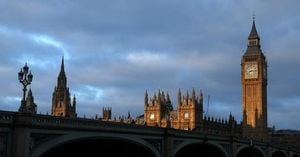On August 19, 2025, President Donald Trump reignited a fierce national debate by taking direct aim at the Smithsonian Institution and its portrayal of American history—specifically, the legacy of slavery. In a striking Truth Social post, Trump declared, "The Museums throughout Washington, but all over the Country are, essentially, the last remaining segment of ‘WOKE’. The Smithsonian is OUT OF CONTROL, where everything discussed is how horrible our Country is, how bad Slavery was, and how unaccomplished the downtrodden have been — Nothing about Success, nothing about Brightness, nothing about the Future." He further announced, "I have instructed my attorneys to go through the Museums, and start the exact same process that has been done with Colleges and Universities where tremendous progress has been made."
This public statement was not just a rhetorical flourish—it marked the formal beginning of a sweeping federal review of the Smithsonian’s exhibitions. According to The Washington Post, the Trump administration’s goal is to remove what it calls “divisive or ideologically driven” content and to promote exhibits that “celebrate American exceptionalism.” The White House has formally required eight major Smithsonian museums, including the National Museum of African American History and Culture, to make "content corrections" within 120 days. The review also extends to the National Museum of American History, the National Air and Space Museum, and the Hirshhorn Museum and Sculpture Garden, among others.
Federal funding provides about 62 percent of the Smithsonian’s operating budget, giving the administration significant leverage over the institution’s programming. Smithsonian Secretary Lonnie Bunch III reportedly received formal correspondence outlining the administration’s expectations for revised content—expectations that align closely with the president’s vision of a more positive, achievement-focused depiction of the nation’s past.
The president’s critique, and the administration’s subsequent actions, have ignited fierce debate over how America’s most prestigious museums should present history. Trump’s central argument is that these institutions dwell excessively on the horrors of slavery and other dark chapters, leaving little room for stories of triumph or hope. In his words: “This Country cannot be WOKE, because WOKE IS BROKE. We have the ‘HOTTEST’ Country in the World, and we want people to talk about it, including in our Museums.”
Yet the historical record stands in stark contrast to the notion that museums exaggerate the brutality of slavery. According to the Equal Justice Initiative, between 1501 and 1867, approximately 12.5 million Africans were kidnapped and forcibly transported across the Atlantic Ocean. Only about 10.7 million survived the journey—a journey so deadly that between 1.2 and 2.4 million perished during the Middle Passage alone, with mortality rates ranging from 10 to 25 percent. The conditions were unspeakably grim: enslaved people were packed into spaces less than five feet high, chained together, and forced to lie in their own waste for weeks. The holds reeked of “urine, vomit, mucous, and horrific odors.”
Sexual violence was both systematic and pervasive. As documented by historians, sailors routinely assaulted African women and girls—some as young as eight or ten years old. Those who resisted were subjected to brutal torture, including forced feeding and other inhumane punishments.
One of the most devastating aspects of American slavery was its hereditary nature, established by law in 1662 Virginia. The doctrine of partus sequitur ventrem—“that which is born follows the womb”—ensured that children born to enslaved mothers would automatically inherit their mother’s enslaved status. This legal innovation, modeled after Roman law applied to livestock, meant that Black women’s children were deemed property, ensuring the perpetuation of slavery for generations. By the time of the Civil War, over a million of the four million enslaved people in America were children under sixteen. These children could be bought, sold, maimed, or killed, and about 30 percent of those born in the upper South between 1820 and 1860 were sold away from their families to the Deep South.
Violence against enslaved people was not sporadic cruelty but systematic torture designed to enforce control. Whipping, branding, sexual assault, burning, and lynching were commonplace. Frederick Douglass once observed, “all the peculiar modes of torture that were resorted to in the West India islands, are resorted to, I believe, even more frequently, in the United States of America.”
Daily life for enslaved people was marked by relentless labor. Most worked from sunrise to sunset, six days a week, with workdays extending up to 18 hours during harvest seasons. The majority toiled in cotton, rice, sugar, and tobacco fields under the constant threat of violence from overseers. Even house workers, who lived under constant surveillance, experienced no real separation between work and personal time. Living conditions were deliberately harsh—cramped cabins with dirt floors, minimal furniture, and inadequate nutrition. Skeletal analyses reveal widespread malnutrition, and during crises like the American Revolution, hundreds died from starvation.
The economic impact of slavery was vast. Cotton production, fueled by enslaved labor, propelled the United States into a global economic powerhouse. The Mississippi River Valley boasted more millionaires per capita than any other region by the Civil War. Major financial institutions, including JP Morgan Chase’s predecessor banks, accepted enslaved people as collateral for loans, sometimes ending up as slaveholders themselves. This intertwining of slavery and finance shaped the nation’s development in ways that still reverberate today.
Despite this legacy of violence and oppression, enslaved people forged vibrant cultural traditions and kinship networks that sustained them. Extended families and community ties offered emotional support and collective resistance in the face of family separation and systematic dehumanization. As The New York Times notes, these networks were “multiple, overlapping, mutually reinforcing communities” based on work, family, religion, and neighborhood connections.
The Smithsonian Institution, for its part, has defended its approach. Leaders reaffirmed their commitment to scholarly excellence, rigorous research, and factual historical presentation. Professional historians and curators have voiced deep concern about political interference. They argue that comprehensive historical understanding requires confronting both the triumphs and the tragedies of the American experience, and that avoiding difficult topics risks creating incomplete, even misleading, narratives.
Public reaction has been swift and divided. Critics of the administration’s approach warn that minimizing the horrors of slavery amounts to dangerous historical revisionism. Supporters, on the other hand, believe that museums should inspire patriotism and focus on America’s achievements, not its failures. Congressional representatives have lined up on both sides, reflecting the nation’s broader polarization over how history should be taught and remembered.
The administrative review is set for completion in early 2026, just ahead of the nation’s 250th anniversary. The timeline is tight, and the practical challenges are formidable: modifying exhibits, revising educational materials, and possibly relocating or removing artifacts—all of which will require significant financial investment and expertise. There’s also uncertainty about what might happen if political leadership changes before the review is finished, potentially leaving the Smithsonian’s long-term plans in limbo.
What happens in Washington could set the tone for cultural institutions nationwide. Universities, libraries, and local museums that receive federal funding may soon face similar pressures to align their programming with shifting political winds. The stakes are high: at issue is nothing less than how America chooses to remember—and learn from—its own history. As this debate unfolds, the nation’s museums find themselves at the center of a struggle over truth, memory, and the meaning of patriotism in the 21st century.





